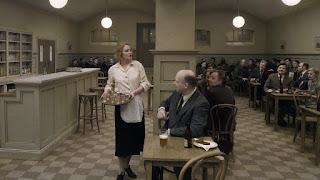A Pigeon Sat on a Branch Reflecting on Existence
Don and I watched A Pigeon Sat on a Branch Reflecting on Existence at the Princess Theatre (Edmonton) on Sunday. If reading that title makes you think: “Hmmm, not sure this one is for me,” then let me encourage you to follow your instinct: It’s probably not for you.
Similar to his previous film, 2007’s You the Living, Swedish filmmaker Roy Andersson’s A Pigeon Sat on a Branch Reflecting on Existence is a super-quirky brain-numbing series of bizarre, though often hilarious and always beautiful, vignettes. While many of these vignettes seem to have no connection to the others, there a number which feature the same two characters: a pair of salesmen trying to sell silly items that will contribute to people having fun (though they never seem to be having any fun themselves). Watching the unfolding story (such as it is) of these two salesmen is indeed great fun, though some of the best scenes don’t involve them at all.
The two films mentioned above are the last parts of a trilogy which began with Songs from the Second Floor (2000). These three films do not resemble any other films ever made, which is one reason why they are rarely seen or appreciated except by those for whom watching an obscure foreign film with little by way of plot and no obvious connection between scenes is sometimes considered a treat (as it is for me).
The camera in A Pigeon Sat on a Branch Reflecting on Existence is as static as in any film I’ve seen, with each scene taking place without any camera movement. The dour characters are almost as static, with little movement by the actors, who often show little or no emotion of any kind (there are a few exceptions). Their faces are pale, as is the cinematography as a whole, making you wonder if they are even alive.
The scenes are almost too absurd to describe, including a marvellous musical number in a 1943 bar and a visit by King Charles XII (from the 18th century) and his troops to a contemporary suburban bar (all taking place in Gothenburg, Sweden). The vignettes are often very sad and very funny at the same time. Sometimes they are even horrific and funny at the same time. So what is Andersson trying to say? That life can be full of tedium, suffering and even horror (especially in the way people sometimes treat each other) but you can still laugh at the absurd meaninglessness of it? Not sure that’s a sentiment I would want to support, which is one reason why I find it difficult to give Andersson’s films more than ***+ in spite of their obvious genius.
So A Pigeon Sat on a Branch Reflecting on Existence gets a solid ***+. My mug is up, but don’t assume that this a recommendation unless you’re a fan of arthouse cinema at its most obscure.


Comments
Post a Comment